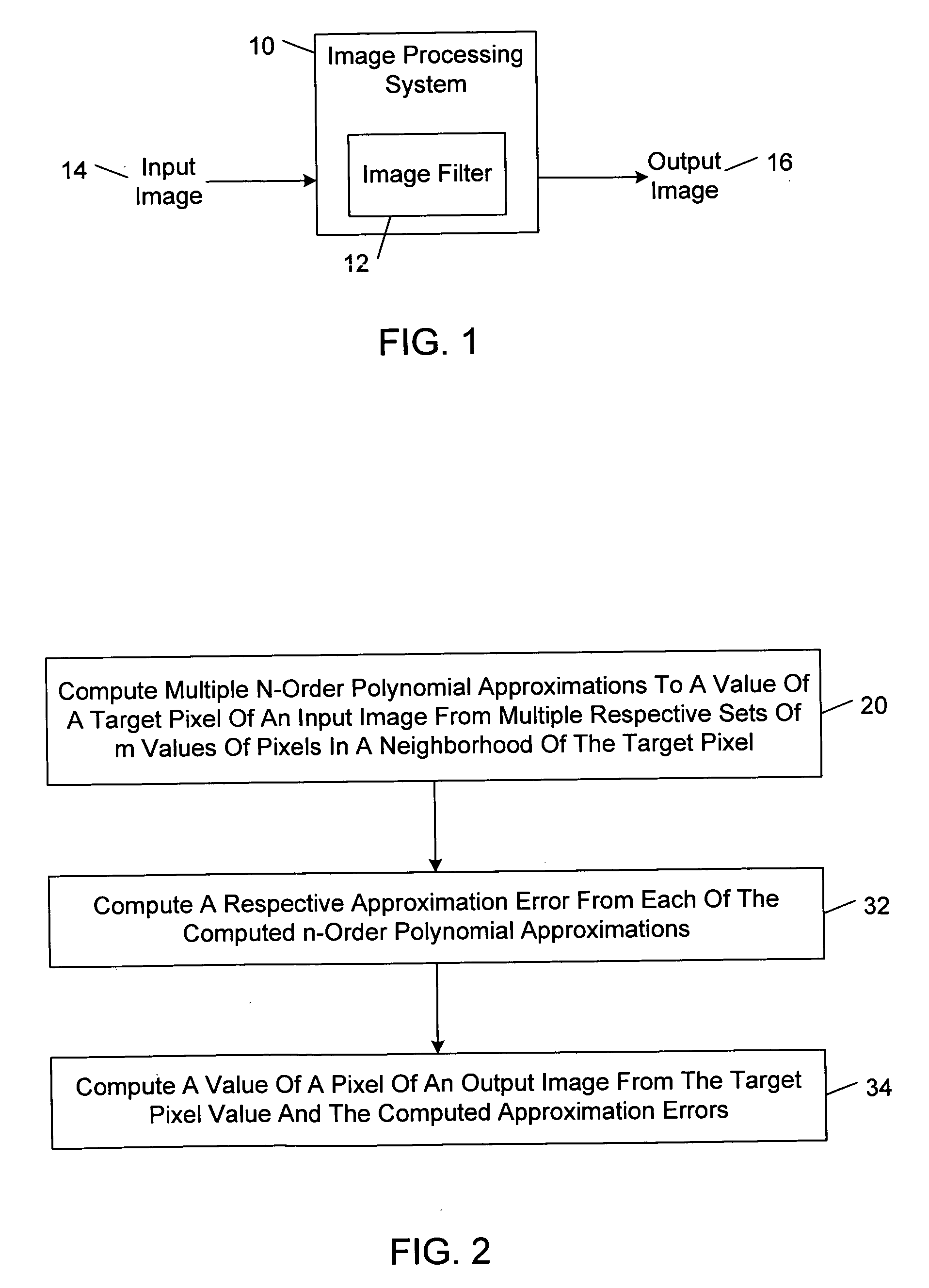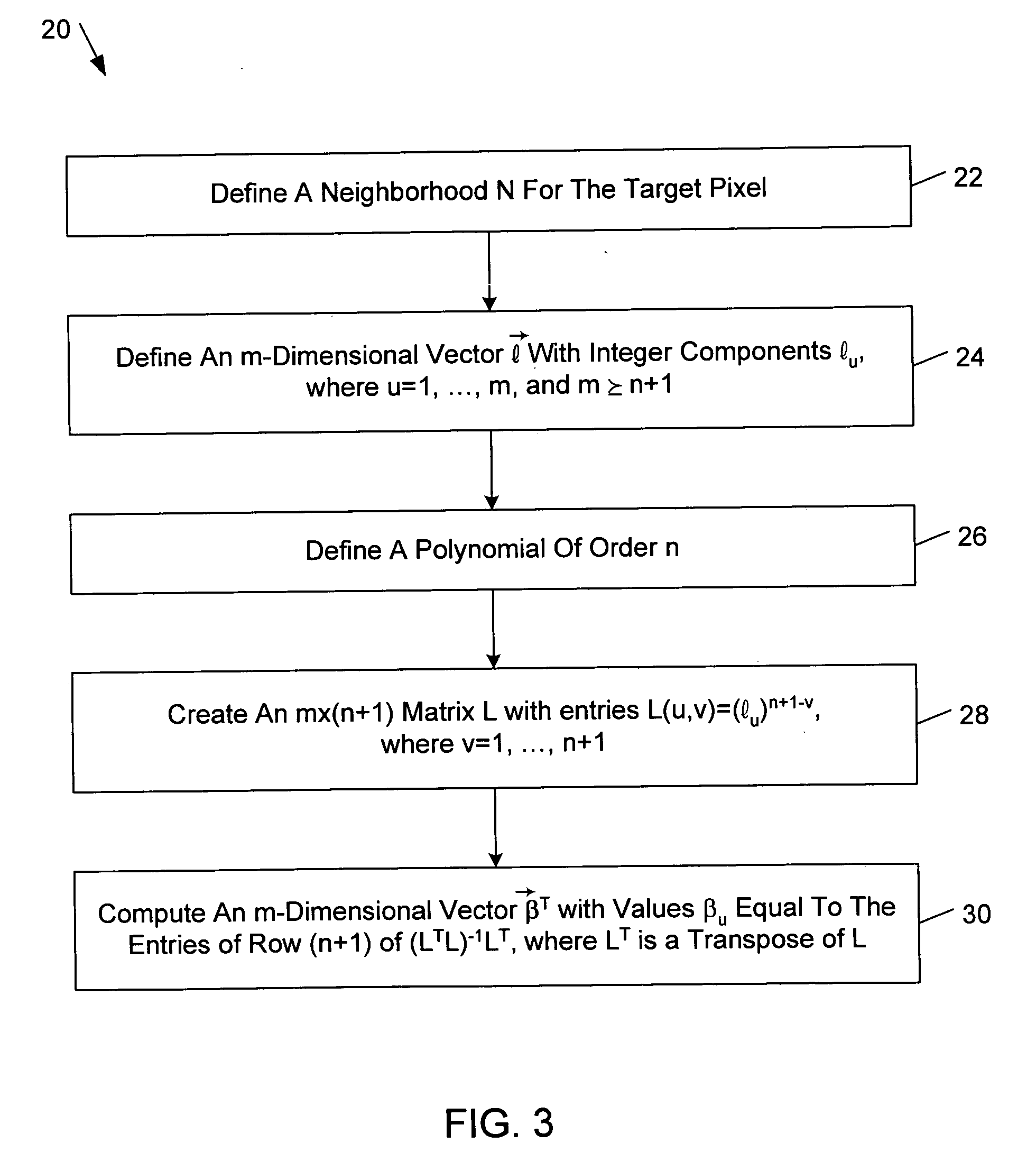Polynomial approximation based image filter methods, systems, and machine-readable media
a filter method and polynomial approximation technology, applied in image enhancement, instruments, applications, etc., can solve the problems of local regions of images of higher resolution (e.g., more than 2 mpixels), but tend not to be accurately represented by piece-wise linear or piece-wise constant approximations
- Summary
- Abstract
- Description
- Claims
- Application Information
AI Technical Summary
Problems solved by technology
Method used
Image
Examples
example 1
[0034] One exemplary first-order robust polynomial filter obtained from equation (9) corresponds to the case where n=1, {right arrow over (l)}=(−1,1), and N corresponds to the punctured square {(0, 1), (0, −1), (1, 0), (−1, 0), (−1, −1), (−1, 1), (1, −1), (1, 1)}. In s this example, L=(-1111)(10)(LTL)-1LT=(1 / 2-1 / 21 / 21 / 2)(11)
and therefore β=(½,½). Accordingly, the corresponding first-order robust filter is given by: g(i,j)=f(i,j)+19∑(a,b)∈Nψ[12[f(i+a,j+b)+f(i-a,j-b)]-f(i,j)](12)
[0035] In this example, pa,b(0)=p−a,−b(0) for all (a,b). Therefore, computational resources may be conserved by joining symmetrical points. This simplification is always possible when {right arrow over (l)} is symmetrical around (0,0). The first-order filter defined in equation (12) may be expanded by writing the neighborhood terms is explicitly as follows: g(i,j)=f(i,j)+29{ψ{[f(i+1,j+1)+f(i-1,j-1)] / 2-f(i,j)}+ψ{[f(i+1,j-1)+f(i-1,j+1)] / 2-f(i,j)}+ψ{[f(i+1,j)+f(i-1,j)] / 2-f(i,j)}+...
example 2
[0037] Some exemplary robust polynomial filters that may be obtained from equation (9) may be generated for the particular case where a quasi-symmetric sampling is considered and m=n+1. The table shown in FIG. 5 provides the components of {right arrow over (β)} of all orders zero through ten for this particular case.
[0038] By using the table shown in FIG. 5, the following exemplary second-order robust filter may be obtained: g(i,j)=f(i,j)+19∑(a,b)∈Nψ[13f(i-a,j-b)+f(i+a,j+b)-13f(i+2a,j+2b)-f(i,j)](14)
[0039] Other embodiments are within the scope of the claims.
[0040] The systems and methods described herein are not limited to any particular hardware or software configuration, but rather they may be implemented in any machine, computing or processing environment, including in digital electronic circuitry or in computer hardware, firmware, or software. In general, the systems may be implemented, in part, in a computer process product tangibly embodied in a machine-readab...
PUM
 Login to View More
Login to View More Abstract
Description
Claims
Application Information
 Login to View More
Login to View More - R&D
- Intellectual Property
- Life Sciences
- Materials
- Tech Scout
- Unparalleled Data Quality
- Higher Quality Content
- 60% Fewer Hallucinations
Browse by: Latest US Patents, China's latest patents, Technical Efficacy Thesaurus, Application Domain, Technology Topic, Popular Technical Reports.
© 2025 PatSnap. All rights reserved.Legal|Privacy policy|Modern Slavery Act Transparency Statement|Sitemap|About US| Contact US: help@patsnap.com



